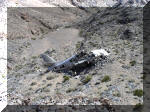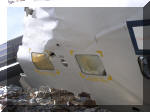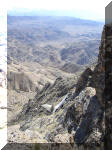|
Aircraft Wrecks in the Mountains and Deserts of the American West SA-16A
One of the toughest, but most interesting wrecks that can be reached in a one day effort is the USAF Grumman SA-16A Albatross in the rugged Panamint Mountains. If you're going for this one you'd better be well prepared, outfitted, and in excellent physical condition. Most people start at 7:00AM and return to their vehicles by 6:00PM. This is one site I've seen only from a distance, so I salute Alan Erickson for his fine effort, and great photos that he has agreed to share with all of us from his 2/5/05 trek to the crash site. #51-001 was assigned to the 580th Air Resupply and Communications Squadron based at Mountain Home AFB, Idaho. On January 24, 1952 the mission of #51-001 was to fly from Mountain Home AFB nonstop to San Diego, California and return to Mountain Home the next morning. This was a classified training mission that supported C.I.A. operations in the cold war. Such Ops included dropping agents in places like China, North Korea, and other very tough spots. At about 6:30PM #51-001 was at 11,000' over Death Valley National Monument when one of its two engines failed. In the dark, with the aircraft loosing altitude, the decision was made to bailout. The five man crew did this successfully and landed minutes later some fifteen miles north of Furnace Creek in Death Valley. #51-001 flew on descending slowly until it crashed virtually intact in the upper reaches of Dolomite Canyon in the Panamint Mountains. If you stop at the scenic overlook on Hwy 190 about sixteen miles west of Stovepipe Wells, and sun is shining, then you will be able to see the gleaming remains of USAF Grumman SA-16A #51-001.
Click on thumbnail to see large view! |
|
|
The wreck of Grumman SA-16A #51-001USAF that crashed
near Townes Pass in the Panamint Mountains on 1/24/52. (photo by Alan Erickson) |
Right side view of #51-001 with part of left wing visible. (Photo by Alan Erickson) |
|
Left side view of fuselage with escape panel details. (Photo by Alan Erickson)
|
Dramatic view of the wreck site and the rugged
features found in the Panamint Mountains. |
|
|
|



